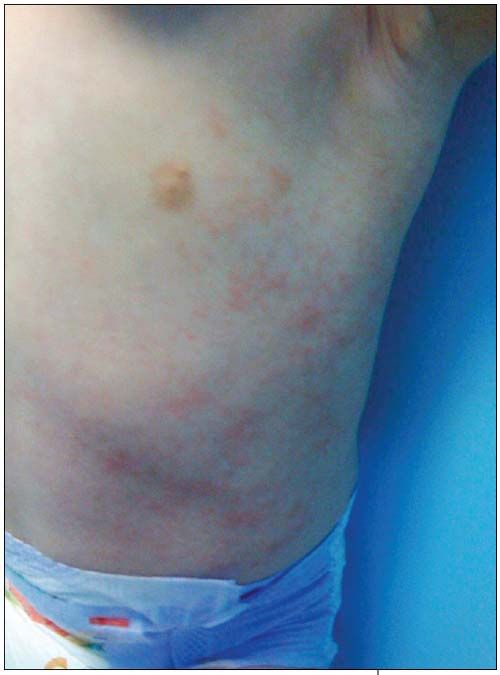Unilateral Laterothoracic Exanthem
This erythematous, blanching papular rash developed on the trunk of a 20-month-old boy 3 days after he became ill with a low-grade fever (temperature of 38.3ºC [101ºF]) and mild upper respiratory tract infection symptoms.
This erythematous, blanching papular rash developed on the trunk of a 20-month-old boy 3 days after he became ill with a low-grade fever (temperature of 38.3ºC [101ºF]) and mild upper respiratory tract infection symptoms. He had not been given antibiotics before the onset of the rash. He had no known exposures. His immunizations, including varicella, were up-to-date.
The rash extended from the left axilla to the left groin. No vesicles were present. The lesions lacked a dermatomal pattern and did not cross the midline of the thorax.

Unilateral laterothoracic exanthem, such as in this child, although rather uncommon, may have a presentation similar to that of the myriad rashes seen in daily practice. Astute clinical evaluation can rule out diseases in the differential diagnosis (such as scarlet fever and Gianotti-Crosti syndrome). Unilateral laterothoracic exanthem is also referred to as asymmetric periflexural exanthem because the rash sometimes begins on an extremity, not the thorax. Asymmetric periflexural exanthem can be distinguished from Gianotti-Crosti syndrome because the latter is symmetric, often develops on the extensor surfaces of the extremities, and may involve the face and buttocks. The thorax is less frequently involved.
Unilateral laterothoracic exanthem has been reported in children aged 8 months to 5 years (mean age of 2 years); it occasionally occurs in older children and is rare in adults. It appears to affect girls more often than boys.
Identification of the causative organism may be considered for possible prevention of complications associated with the underlying virus (eg, when Parvovirus B19 is found to be a causative agent).
Spontaneous resolution within a few weeks is the norm. Reassurance is the only treatment necessary. This child recovered uneventfully after 3 weeks.
Recognize & Refer: Hemangiomas in pediatrics
July 17th 2019Contemporary Pediatrics sits down exclusively with Sheila Fallon Friedlander, MD, a professor dermatology and pediatrics, to discuss the one key condition for which she believes community pediatricians should be especially aware-hemangiomas.